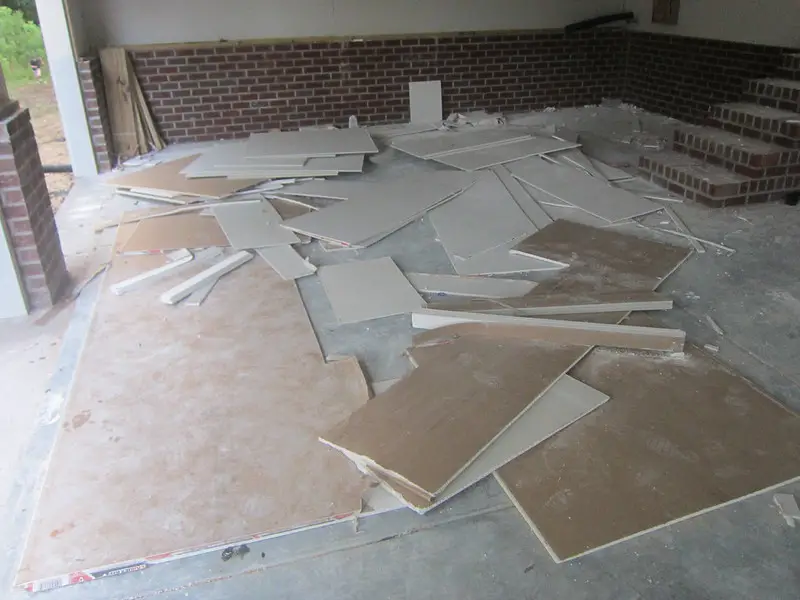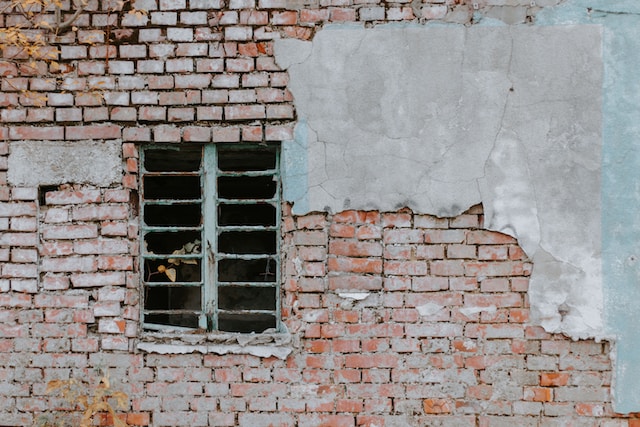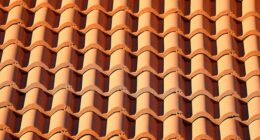Drywall is easier to install and more cost-effective than plaster, making it a popular choice for modern construction projects. However, plaster has stood the test of time as a reliable wall finish with a timeless aesthetic.
Drywall
(Photo by Jesus Rodriguez on Flickr)

Drywall, also known as gypsum board, is a popular wall finishing material that has been widely used in construction projects for decades. It is made of compressed gypsum and covered with paper or fiberglass mats. One of the significant advantages of drywall is its ease of installation. The process involves cutting the panels to size and attaching them to the framing using screws or nails.
There are different types of drywall available in the market, each designed for specific applications. For instance, moisture-resistant drywall is ideal for areas prone to high humidity levels like bathrooms and kitchens. On the other hand, fire-resistant drywall is specifically formulated with additives that help retard fire spread.
Another advantage of using drywall over plaster is its cost-effectiveness. Drywall materials are less expensive compared to plaster materials making it a preferred choice for many builders and homeowners alike.
However, one disadvantage associated with drywalls includes their fragility; they are easily damaged when subjected to impact forces such as knocks or bumps during transportation or installation. Additionally, they do not offer excellent insulation properties compared to plaster walls since sound waves can pass through them quickly.
Despite some drawbacks associated with this wall finishing material option – which can be mitigated by choosing specialized options -drywalls remain an attractive option due to their affordability and easy installation process
Plaster
(Photo by Pawel Czerwinski on Unsplash )

Plaster is a building material that has been used for centuries. It consists of various materials such as lime, sand, and water. Plaster can be applied to walls, ceilings or other surfaces to create a smooth finish suitable for painting or wallpapering.
One of the advantages of plaster is its durability. Plastered surfaces are strong and resistant to damage from impact or moisture. Unlike drywall, which can crack easily if bumped or dented.
Plaster also offers excellent insulation properties making it an ideal choice for soundproofing rooms in your home. Additionally, plaster provides better fire resistance compared to drywall; hence it’s commonly found in older buildings where safety regulations were less strict.
Moreover, plaster requires skilled laborers who know how to apply this material properly; thus hiring professional contractors will ensure high-quality workmanship and longevity of the finished product.
However, one downside of using plaster is that it’s more expensive than drywall due to the materials required and longer installation times needed by experienced workers. Also applying multiple coats may result in additional costs as well as drying time before finishing touches like painting can occur.
In summary, while there are advantages and disadvantages associated with using plaster over drywall in construction projects; ultimately choosing what best fits your needs depends on factors such as budget limitations versus long-term investment goals towards home improvement projects.
Plaster Vs. Drywall – Key differences
Plaster and drywall are two common building materials used for interior walls and ceilings. Although they are both used to create smooth surfaces, they differ in terms of composition, installation process, durability, and cost.
Composition:
- Plaster is made of a mixture of gypsum, lime, and sand, and is applied in layers to a wood or metal lath, which gives it its strength and support.
- Drywall, also known as gypsum board or sheetrock, is made of compressed gypsum, sandwiched between two sheets of paper or fiberglass.
Installation Process:
- Plaster requires a skilled craftsman to apply and is a labor-intensive process. It is applied in several layers, and each layer must be allowed to dry before the next one is added. This process can take several days.
- Drywall installation is much faster and can be done by one or two people. The drywall sheets are hung on metal or wood studs using screws, and then the seams are taped and covered with joint compound.
Durability:
- Plaster is known for its durability and can last for many decades without needing repairs.
- Drywall is not as durable as plaster and can be easily damaged by water or physical impact.
Cost:
- Plaster is more expensive than drywall, mainly because of the labor-intensive installation process.
- Drywall is less expensive than plaster, and the materials are readily available.
Plaster is a more traditional and durable building material that requires skilled craftsmen to install. Drywall, on the other hand, is faster to install, less expensive, but not as durable as plaster. Ultimately, the choice between plaster and drywall will depend on factors such as budget, aesthetic preferences, and the desired level of durability.
Plaster Vs. Drywall – Which is better?
Plaster has been used for centuries and has a timeless appeal that many homeowners love. It’s made of gypsum or lime mixed with water to create a smooth finish. Plaster walls are extremely durable and can last for decades without showing any signs of wear and tear.
On the other hand, drywall is a more modern option that was invented in the early 1900s. It’s made of gypsum plaster sandwiched between two sheets of paper or fiberglass. Drywall is cheaper than plaster and easier to install, making it a popular choice for new builds or renovations.
While both materials have their advantages, each also has some disadvantages worth considering. For instance, while plaster walls can be repaired easily by filling in holes with fresh plaster mixture, repairing damaged drywalls requires cutting out the damaged section before patching up.
Ultimately, which material you choose will depend on your unique circumstances – from budget constraints to personal preferences about look-and-feel – so it’s important to weigh all factors carefully before making your decision.
Can you use plaster for drywall?
Plaster can be used as a surface coating over gypsum board (also known as drywall). This method involves applying a thin layer of plaster over the entire surface area to create a smooth finish. However, using only plaster in place of drywall is not recommended because it lacks the structural integrity that makes gypsum board suitable for walls and ceilings.
Another reason why using only plaster instead of drywall isn’t practical is that it takes longer to install and requires more skill. With traditional lath and plaster techniques, a lot of time is needed for each coat to fully cure before adding another layer.
So while it’s possible to use plaster on top or alongside drywall, it’s not an ideal replacement for this material due to its lack of strength and lengthy installation process. Ultimately, deciding which one will work best depends on your needs such as budget limitations or project requirements like soundproofing or fire resistance capabilities.
Advantages and disadvantages of plaster
Plaster has been used for centuries as a traditional building material. It’s a mixture of gypsum, water, and sand that creates a smooth surface when applied to walls or ceilings. While plaster is still used today in some homes, it has both advantages and disadvantages.
One major advantage of plaster is its durability. Plaster can last for decades without needing any significant repairs or maintenance work. Additionally, it provides excellent soundproofing and thermal insulation qualities that help regulate the temperature inside your home.
On the other hand, one disadvantage of using plaster is that it requires skilled labor to be installed correctly. The installation process typically takes longer than installing drywall due to the need for multiple coats and drying time between them.
Another disadvantage of using plaster is cost – it’s more expensive compared to drywall materials since professional skills are required during installation procedures which also makes labour costs higher too
When comparing with Drywalls; Plasters have less design options because they require skilled laborers who can create intricate patterns by hand – making customization rather costly if you want something beyond plain surfaces.
While there are certainly benefits associated with using plaster in your home’s construction project such as its longevity & insulating features but there are also drawbacks like its high cost & requirement for specialized expertise during installations at times limiting your decorative options too!
Advantages and disadvantages of drywall
Drywall, also known as gypsum board or plasterboard, is a popular building material used in residential and commercial construction. It consists of sheets of compressed gypsum core sandwiched between two layers of paper or fiberglass mats.
One advantage of drywall is that it is relatively easy to install and can be finished quickly compared to other wall finishes. It also provides a smooth surface for painting, wallpapering or tiling.
Another advantage is that it is fire-resistant due to the presence of hydrated calcium sulfate in its composition. This makes it an ideal choice for buildings where fire safety standards need to be met.
However, drywall does have some disadvantages. One drawback is that it can easily crack under pressure or impact. This means that care must be taken when installing fixtures such as shelves or cabinets on walls made from drywall.
Another disadvantage is that drywall does not handle moisture well and can become damaged if exposed to water. Mold can grow on damp drywall which poses potential health risks.
In addition, while there are different types of drywall available with varying thicknesses, they do not offer significant insulation properties beyond soundproofing capabilities.
Featured Image By – Cory Woodward on Unsplash








